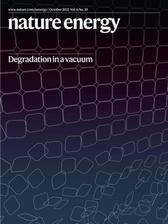Christian Weindl, Peter Müller-Buschbaum, Renjun Guo and Suzhe Liang (from left) prepare the experimental setup for operando measurements with synchrotron radiation in a laboratory at TU München. (Photo: Chair of Functional Materials, TUM, Kun Sun.)
An international team of scientists led by the Technical University of Munich (TUM) has used PETRA III to observe for the first time how different atmospheres affect the operation of novel high-performance solar cells. They discovered that vacuum leads to the rapid degradation of the structural composition and thus also the efficiency of the cells, whereas a nitrogen atmosphere stops this degradation. The team describes the mechanisms that lead to this behaviour in the scientific journal “Nature Energy”.
Solar cells made of perovskite are a promising alternative to the conventional models made of silicon. Perovskites are very common minerals that make up large parts of the Earth´s mantle. Solar cells made of this material can convert blue and green light better than silicon cells and can be produced cheaply in thinner layers. In the last ten years, researchers have been able to increase the efficiency of perovskite solar cells from 3.8 % to 25.5 %, making them competitive with single-crystal silicon solar cells. However, the main obstacle to industrialisation is the low long-term stability of the cells. Within a few hours, the electricity yield can drop dramatically because the nanostructure of the crystals changes and they segregate. In their measurements at the PETRA III beamline P03, the research group has now shown that different inert atmospheres can accelerate or suppress degradation paths for perovskite solar cells.
“A long operating life is the biggest challenge for the application of perovskite solar cells in everyday life,” says Peter Müller-Buschbaum, professor at the Chair of Functional Materials at TUM. “Understanding the degradation mechanisms of these solar cells gives us the opportunity to address this problem.”
In laboratory experiments, it is common to conduct studies of such solar cells under inert atmospheres: Nitrogen or vacuum largely avoid contact of the solar cell with water or oxygen, both of which are harmful to solar cells.
“The simplification that an inert atmosphere is all that matters in these experiments is wrong,” explains first author Renjun Guo (TUM). “Our solar cells behaved totally differently in vacuum or nitrogen – their stability is significantly increased in an inert nitrogen atmosphere. Even though both nitrogen and vacuum are considered inert, atmospheric conditions have a strong influence on experimental results.”
To study the structural properties of the perovskite solar cells, the researchers used special synchrotron X-ray scattering techniques at the PETRA beamline P03. This enabled them to visualise structural changes in the light-absorbing perovskite layer in the solar cells.
“With synchrotron radiation, you can follow the structural and morphological development of perovskite solar cells during operation under different external conditions,” says Stephan V. Roth (DESY and KTH Stockholm), co-author and head of beamline P03. “We were thus able to directly observe the structural changes in the perovskite and thus open the “black box” of degradation mechanisms.”
Changes in the crystal and surface structure of the perovskite go hand in hand with loss of solar cell performance. Nitrogen environment stabilises the crystal lattice; structure and morphology remain unchanged. In contrast, the solar cells under vacuum experienced structural changes in the lattice, resulting in phase segregation within the perovskite layer and loss of solar cell performance.
“We recommend that researchers using vacuum or nitrogen to avoid the effects of water and atmospheric oxygen take into account how a vacuum or nitrogen condition affects their experimental results obtained with different characterisation methods such as scattering, spectroscopy and microscopy,” Mueller-Buschbaum reports. “Our discoveries could improve test protocols for experiments on the long-term stability of perovskite solar cells and raise awareness of such effects in degradation studies also on other novel solar cells such as organic solar cells and quantum dot solar cells.”
(from DESY News)
Reference
Renjun Guo, Dan Han, Wei Chen, Linjie Dai, Kangyu Ji, Qiu Xiong, Saisai Li, Lennart K. Reb, Manuel A. Scheel, Shambhavi Pratap, Nian Li, Shanshan Yin, Tianxiao Xiao, Suzhe Liang, Anna Lena Oechsle, Christian L. Weindl, Matthias Schwartzkopf, Hubert Ebert, Peng Gao, Kai Wang, Mingjian Yuan, Neil C. Greenham, Samuel D. Stranks, Stephan V. Roth, Richard H. Friend, Peter Müller-Buschbaum: Degradation mechanisms of perovskite solar cells under vacuum and one atmosphere of nitrogen; Nature Energy, Oct. 13, 2021 – DOI: 10.1038/s41560-021-00912-8








